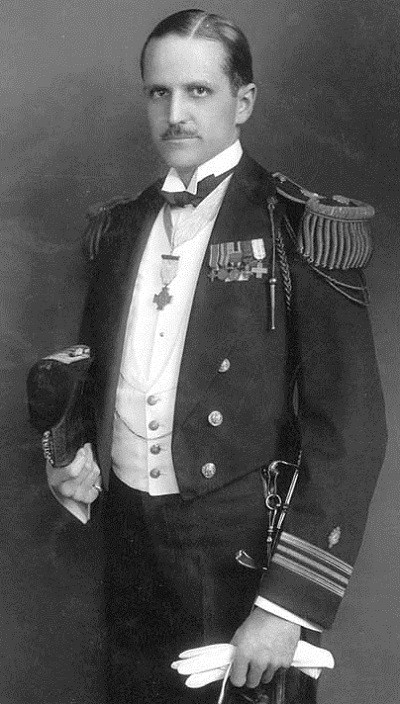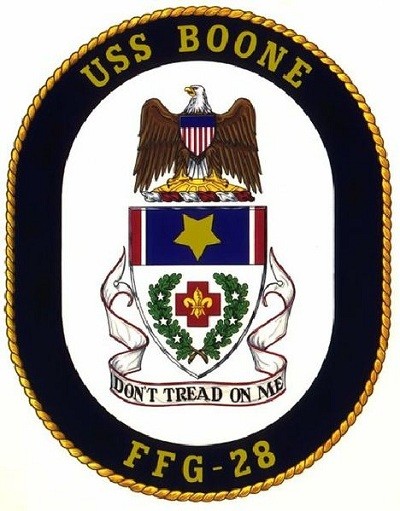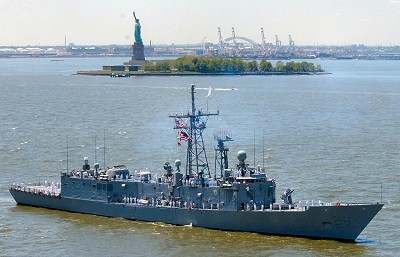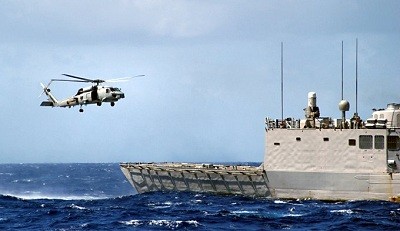Boone (FFG-28)
1982-2012
Joel Thompson Boone, born on 29 August 1889 in St. Clair, Pa., son of William A. and Annie T. Boone, graduated from the Mercersburg Academy, Mercersburg, Pa., in 1909, and in June 1913 from Hahnemann Medical College in Philadelphia, Pa. The following April, he was appointed from that state as a lieutenant (junior grade) in the Medical Corps of the Naval Reserve. He married Helen E. Koch of Pottsville, Pa. (20 June 1914), a union that produced a daughter, Suzanne, five grandchildren, and six great grandchildren.
Boone was attached to the Naval Hospital, Portsmouth, N.H. (July–September 1914), after which he completed his graduate studies at the Navy Medical School, Washington, D.C. (September 1914–April 1915). He transferred (May 1915) to the Regular Navy, and served with the Artillery Battalion, Marine Corps Expeditionary Force (May 1915–June 1916), during the U.S. occupation of Haiti.
Boone then (September 1916–August 1917) served on board Wyoming (Battleship No. 32). He was detached from that ship and the following month reported for duty with the Sixth Marines at Quantico, Va. He deployed with that regiment to France in early October 1917, and participated with them as Battalion and Regimental Surgeon and later as the Assistant Division Surgeon with the Army’s 2d Infantry Division during the following battles and campaigns: Defense Sector south of Verdun; Aisne; Aisne-Marne; St. Mihiel; Champagne; and Meuse-Argonne.
A heavy German barrage of high explosive and poison gas shells caused heavy casualties among the Sixth Marines at and in the vicinity of Vierzy, France, on 19 July 1918. “The situation was very bad,” he later recalled, “[a] direct hit got a lot of our people. We soon ran out of supplies. I knew we couldn’t take care of wounds without surgical dressings and splints. But the roads were blocked, and supply trucks and ambulances couldn’t get through to us.” Boone left the shelter of a ravine and entered an open field without protection, southeast of Vierzy, near the cemetery, and on the road south from that town. He moved through a thick mist of gas and heavy enemy fire of all calibers, and applied dressings and first aid to wounded Marines. After having exhausted dressings and supplies, he commandeered a motorcycle with a sidecar and went for supplies. With absolute disregard for his personal safety, he raced through the heavy large-caliber fire and poison gas. He returned quickly with a sidecar load, and administered them in saving the lives of the wounded. Later that day, Boone made a second trip under the same conditions and retrieved additional supplies. He subsequently received the Medal of Honor for his heroic actions.

Following the Armistice, Boone took part in the march to the Rhine bridgeheads in Germany with the Army of Occupation, and then (February 1919), returned to the United States. He served in the Bureau of Medicine and Surgery, Washington, D.C., and as the Director of the Bureau of Naval Affairs, American Red Cross (March 1919–May 1922). Boone then reported as the Medical Officer on board the presidential yacht Mayflower (PY-1). During his time on board, he served as the physician to Presidents Warren G. Harding and Calvin Coolidge, until Mayflower was decommissioned on 22 March 1929.
Boone then began his assignment as the Physician to the White House, attending to President Herbert C. Hoover (22 March 1929–April 1933). After completing a general postgraduate course at the Medical School, Washington, D.C. (May), he reported to the hospital ship Relief (AH-1), serving as Chief of Medicine of that vessel until June 1935. He followed his sea duty by transferring to the Naval Hospital, San Diego, Calif., and then (August 1936) as Force Medical Officer, Fleet Marine Force. In November 1938, he was ordered to the aircraft carrier Saratoga (CV-3) as her Senior Medical Officer. In July 1939, he assumed command of the Naval Dispensary at Long Beach, Calif. Early in the New Year, Boone received orders to be Fleet Medical Officer of Commander Base Force, U.S. Fleet, and served on board the submarine tender Argonne (AS-10).
He became the Senior Medical Officer at Naval Air Station, San Diego (December 1940–April 1943), and the following month transferred to the Naval Hospital in Seattle, Wash., as Medical Officer-in-Command. In April 1945, Boone was promoted to Commodore and ordered to report as Fleet Medical Officer to Adm. William F. Halsey, Jr., Commander, Third Fleet. Halsey selected Boone to be one of the three officers that liberated Allied prisoners of war prior to the military occupation of the Japanese home islands. In addition, Boone represented the Naval Medical Corps at the surrender ceremonies of the Japanese on board the battleship Missouri (BB-63) in Tōkyō Bay (2 September 1945).
In November 1945, Boone was ordered to the Bureau of Medicine and Surgery, Washington, pending further assignment. He served as District Medical Officer, Eleventh Naval District at San Diego (January 1946). In April of that year he also became Inspector of Medical Department Activities, Pacific Coast, with additional duty as Medical Officer, Western Sea Frontier. He furthermore served as Medical Advisor to the Federal Coal Mines Administrator, and as Director of the Medical Survey of the Coal Industry (May 1946–June 1947). Boone received an appointment as Executive Secretary on the Secretary of Defense’s Committee on Medical and Hospital Services of the Armed Forces (early 1948), and later as Secretary of the Committee on Federal Medical Services of the First Commission on Organization of the Executive Branch of the Government, generally known as the Hoover Commission.
Boone was detached (1 September 1949) as General Inspector, Medical, having been appointed Chief of Joint Plans and Action Division, Officer of Medical Services, Department of Defense. In March 1950, he was ordered detached and reassigned as General Inspector, Medical Department Activities. While on the latter assignment, Adm. Forrest P. Sherman, the Chief of Naval Operations, ordered him on a special mission to Japan and Korea during the Korean War. Because of his physical disability, Boone was placed on the retired list (1 December 1950), with the rank of vice admiral. Following his retirement from the Navy, he served as Chief Medical Director of the Veterans Administration (1 March 1951–1954).
His many awards include the Distinguished Service Cross (Army), Silver Star with five Oak Leaf Clusters (Army), and Purple Heart with two Oak Leaf Clusters. Boone died on 2 April 1974 from arteriosclerotic heart disease, and is buried at Arlington National Cemetery, Arlington, Va.
For the ship's Command Operations Reports see (http://www.history.navy.mil/research/archives/command-operations-reports/ships/b/boone-ffg-28-i.html).
(FFG-28: displacement 4,086; length 445'; beam 47'; draft 26'; speed 29+ knots; complement 215; armament RIM-156 SM-1MR Standard surface-to-air missiles, RGM-84 Harpoon surface-to-surface missiles, 1 76 millimeter rapid fire gun, 1 Mk 15 Close In Weapon System (CIWS), 6 Mk 32 torpedo tubes, and 4 .50-caliber machine guns; aircraft 2 Kaman SH-2 Seasprite Light Airborne Multi-Purpose System (LAMPS) II helicopters; class Oliver Hazard Perry)
Boone (FFG-28) was laid down on 27 March 1979 at Seattle, Wash., by Todd Pacific Shipyards Corp.; launched on 16 January 1980; sponsored by Mrs. Suzanne Boone Heller, daughter of the late Vice Adm. Boone; and commissioned on 15 May 1982, Cmdr. Claude A. La Varre in command.

The Shield
At the chief, or upper portion of the shield, are the colors of the Distinguished Service Cross Ribbon, signifying the award of this medal to Boone while serving with the Army’s 2d Infantry Division in France. The reversed gold star alludes to Boone’s Medal of Honor. The red cross, a symbol of medical service, bears a fleur-de-lis, referring to Boone’s illustrious service in France. Oak, a symbol of strength, is formed into a wreath denoting honor and excellence. Medical officers of the Navy wear oak leaves. The six white stars represent his Silver Star with five Oak Leaf Clusters.
The Crest
The eagle on a globe refers to the U.S. Marine Corps insignia and Boone’s service with the Marines. The eagle and U.S. shield also reflects Boone’s service to three presidents, and his later association with the Veterans Administration.
The Motto
The scroll, its colors alluding to the first navy jack, bears the motto of that flag. The phrase, “Don’t Tread on Me,” reminds us of the American Revolution, and also sets the standard for the traditional rules of engagement of the United States Navy. It serves as fair warning to potential enemies of the lethality of a warship and the Navy’s propensity to prevail in battle against forces of apparently superior advantage.

Boone, with a Sikorsky SH-60B Seahawk of Helicopter Antisubmarine Light Squadron (HSL) 36 and a Coast Guard Law Enforcement Team (TACLET) embarked, boarded and seized sailboat Endeavor off the coast of Haiti and Jamaica (29 March 1987). The boarders took three American narcotics smugglers prisoner, and confiscated 67 bales of marijuana with an estimated street value in excess of $500,000. A Boone volunteer prize crew sailed Endeavor over 110 nautical miles to Guantánamo Bay, Cuba. The frigate intercepted and seized vessel El Chapu Two and seven Panamanian narcotics smugglers discovered on board (8 April) and turned them over to the Panamanian government. While en route to Nassau, Bahamas (0300 on 16 April), Boone responded to a distress call from merchant vessel Avril Star, which was about to run aground off Great Abaco Island. Boone rescued and towed the ship for 12 hours into Nassau.
A SH-60B Seahawk (BuNo 162113), of embarked HSL-42, Detachment 3, fell into the Mediterranean during landing qualifications in heavy seas and zero visibility, while Boone made for the Persian Gulf (2 August 1989). The ship rescued all three crewmen.
Boone “shuddered” as she ran aground while passing southbound through the Suez Canal (at 0302 on 26 February 1992). Divers inspected the shaft and hull while she anchored in the Great Bitter Lake. They did not discover substantial damage, but a low frequency noise subsequently detected in the after part of the ship compelled Cmdr. W. Michael Dunaway, her commanding officer, to restrict her speed while steaming between 16 and 21 knots. Boone took part in UN sanctions against Iraq while patrolling the Red Sea, and also moored at Safaga, Egypt, while divers again inspected her without results (5–6 March).
Sailors from Boone’s ships company and her embarked Coast Guard Law Enforcement Detachment (LEDET) boarded a suspicious go-fast, and detained the crew as narcotics smuggling suspects, turning them over to the proper authorities during a deployment to the Caribbean and Eastern Pacific (1 October 2002–1 April 2003). During another routine query of a fishing vessel, Boone’s LEDET boarded and searched the boat. The smugglers tossed many bales overboard, but the boarders discovered more than 100 bales of cocaine still stashed within the vessel and detained the ten crewmembers.
A Grumman E-2C Hawkeye of Carrier Airborne Early Warning Squadron (VAW) 77 spotted a suspicious go-fast boat south of Ecuador (22 January 2003). The Hawkeye passed the information to a Lockheed P-3C Orion of Patrol Squadron (VP) 94. “Once they were spotted, the go-fast’s crew began throwing drugs into the water, so our VP-94 crew threw markers out to allow the contraband to be recovered,” Lt. Cmdr. Robert Hill, officer-in-charge of VP-94’s detachment to Puerto Rico, explained. The planes directed Boone and her embarked SH-60B Seahawk of HSL-42, Detachment 2, to the area, and the frigate recovered 4,000 pounds of narcotics with a street value of $90 million. The interception led to the seizure of the boat and the arrest of six smugglers.
The ship’s busy deployment concluded with an extraordinary rescue at sea. Fire Controlman 2d Class Elton Evatt spotted 60-foot fishing vessel Challenger, adrift with a broken down engine, in the Eastern Pacific (5 February 2003). Boone investigated and discovered 160 Ecuadorian men, women, and children, who had all but consumed the last of their fresh water. Sailors from Boone’s ships company and her embarked LEDET boarded Challenger and transferred the people to the frigate, where other sailors gave the castaways blankets and a hot meal. The boarders meanwhile discovered nearly 4,000 gallons of water flooding the main engine compartment of the fishing vessel, and that the crowded and dilapidated boat proved woefully inadequate to humanely sustain 160 people. Boone sank Challenger to prevent her from becoming a threat to navigation, and four days later repatriated the Ecuadorians to their home country at Manta, Ecuador. During Boone’s deployment, her boarding team boarded ten vessels: four go-fasts and six fishing vessels suspected of supporting drug traffickers.

Three fishermen disappeared during a recreational fishing voyage in Florida waters on Christmas day 2004. Three days later, Boone rescued the trio. She transferred them to a Coast Guard Eurocopter HH-65A Dolphin from Miami, Fla., which flew them ashore.
The ship took part in the annual Lobster Festival at Rockland, Me. (early August 2004). A patch of mulch near the base of the pier where the ship lay moored caught fire and smoldered. The smoldering flames glowed “bright red,” Operations Specialist 1st Class Jerry Loving recalled, as festival attendees thronged the carnival tents flanking the 75-year old wooden structure. Loving and Electronics Technician 3d Class Ned Stacey contained the blaze until firefighters of the Rockland Fire Department arrived and extinguished it before it spread to the tents.
Boone emergency sortied with 13 other ships from Mayport, Fla., to avoid Tropical Storm Ophelia (8 September 2005). The ship and Venom 511, her embarked SH-60B Seahawk from HSL-48 Detachment 5, intercepted a drug-smuggling speedboat while en route from Algeria to Spain during a deployment to the Mediterranean, on 24 August 2006. Boone chased the smugglers but they outran the frigate. Venom 511 flew over the craft, and the smugglers abandoned their cargo, consisting of five packages of hashish weighing 90 kilograms (198.42 pounds), and fled into Algerian territorial waters. The frigate recovered the hashish, valued at “several hundred million dollars.” A few hours later and near the same location, Boone encountered two small rubber boats in apparent distress. She closed the boats and discovered 26 people clinging to the craft. The frigate directed a Spanish coast guard vessel to the scene, and she rescued the castaways.
Boone lost her rudder while patrolling the western Mediterranean (30 November 2006). A securing nut at the end of the frigate’s rudder post failed and the rudder disappeared beneath the waves. The ship’s auxiliary propulsion units, however, gave her “a limited amount of maneuverability,” Surface Forces Atlantic Fleet spokesman Paul Taylor explained. Boone sent a distress call, and Canadian area air defense destroyer Iroquois (DDG.280) responded, providing divers who investigated the frigate’s underside. The following day, German replenishment oiler Spessart (A.1442) towed Boone into Rota, Spain, where she completed repairs (2–28 December).
The frigate rescued 50 migrants while investigating a suspicious vessel (3 September 2008). Joint Interagency Task Force South (JIATF-S) directed Boone to examine the boat. Her boarders, from the ship’s company and LEDET 406, discovered the people packed on board, and interviewed the migrants. They decided to transfer the people to the frigate for their health and safety, and crewmembers then provided them with medical attention, food, clothing, and showers, before returning the people ashore. During this deployment, she also intercepted 3.6 tons of narcotics.
Decommissioned at Mayport on 23 February 2012, Boone lies moored, pending disposal, at the Naval Sea Systems Command (NavSea) Inactive Ships On-site Maintenance Office, Philadelphia, Pa.
Detailed history under construction.
Mark L. Evans


